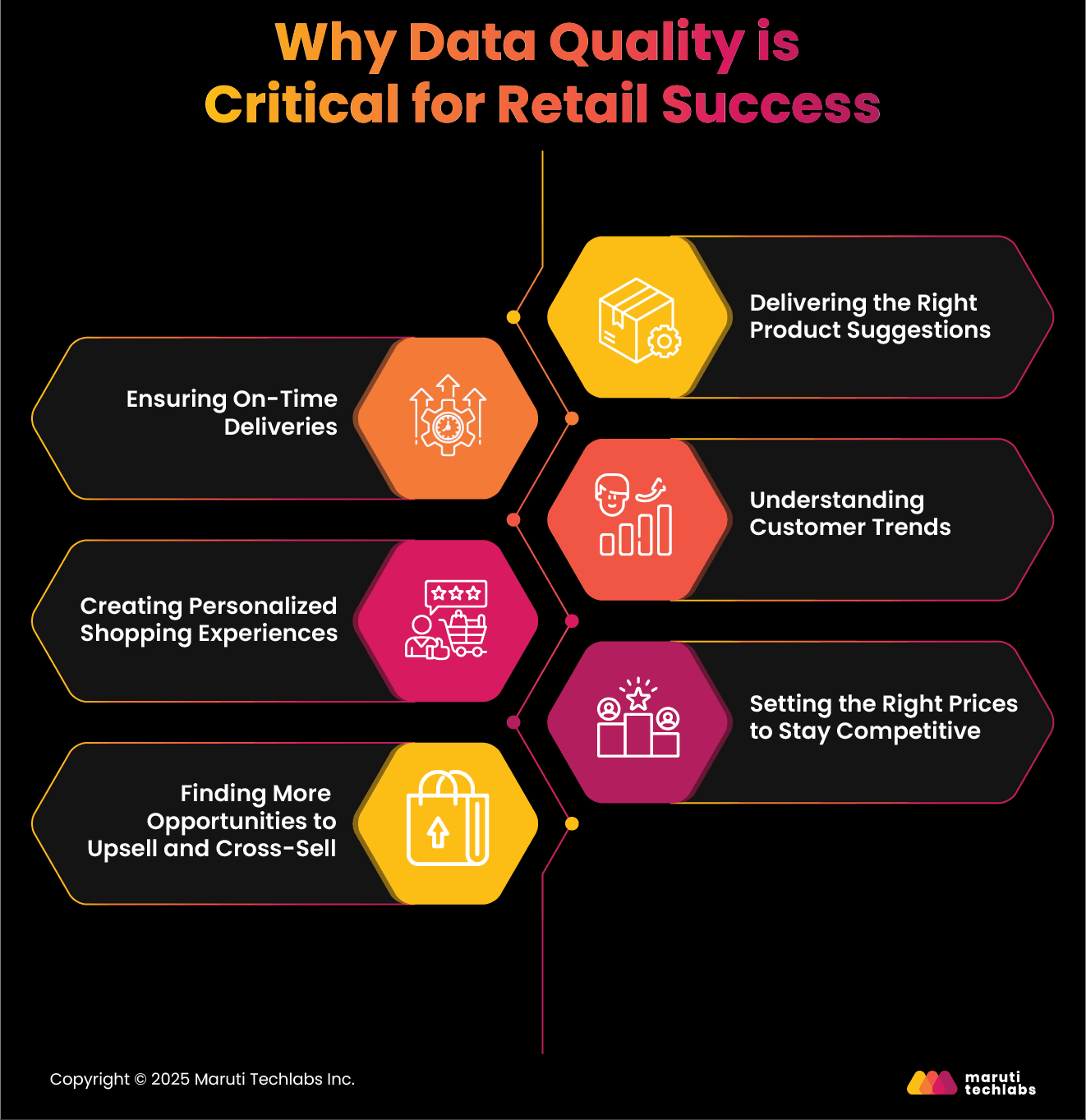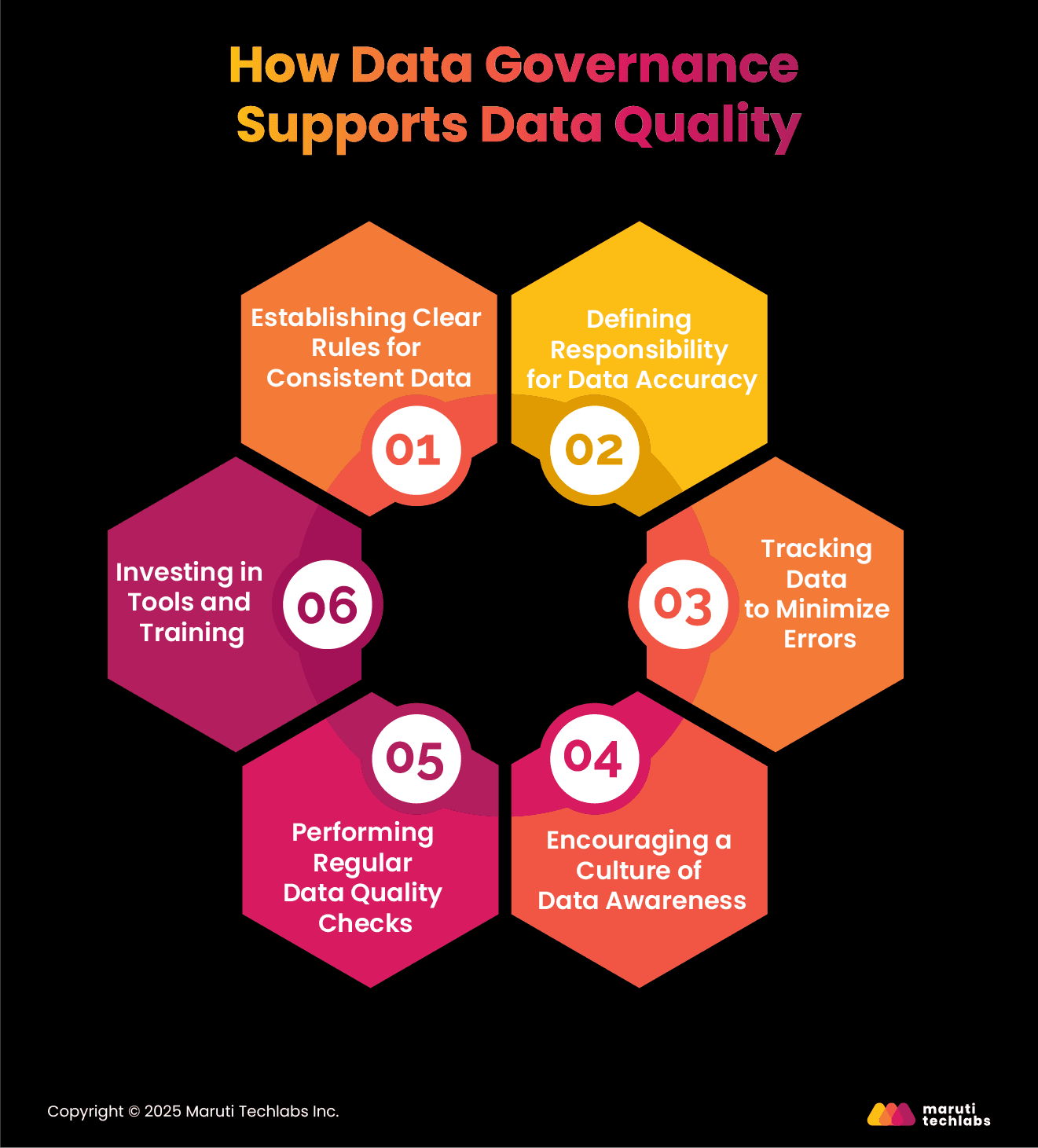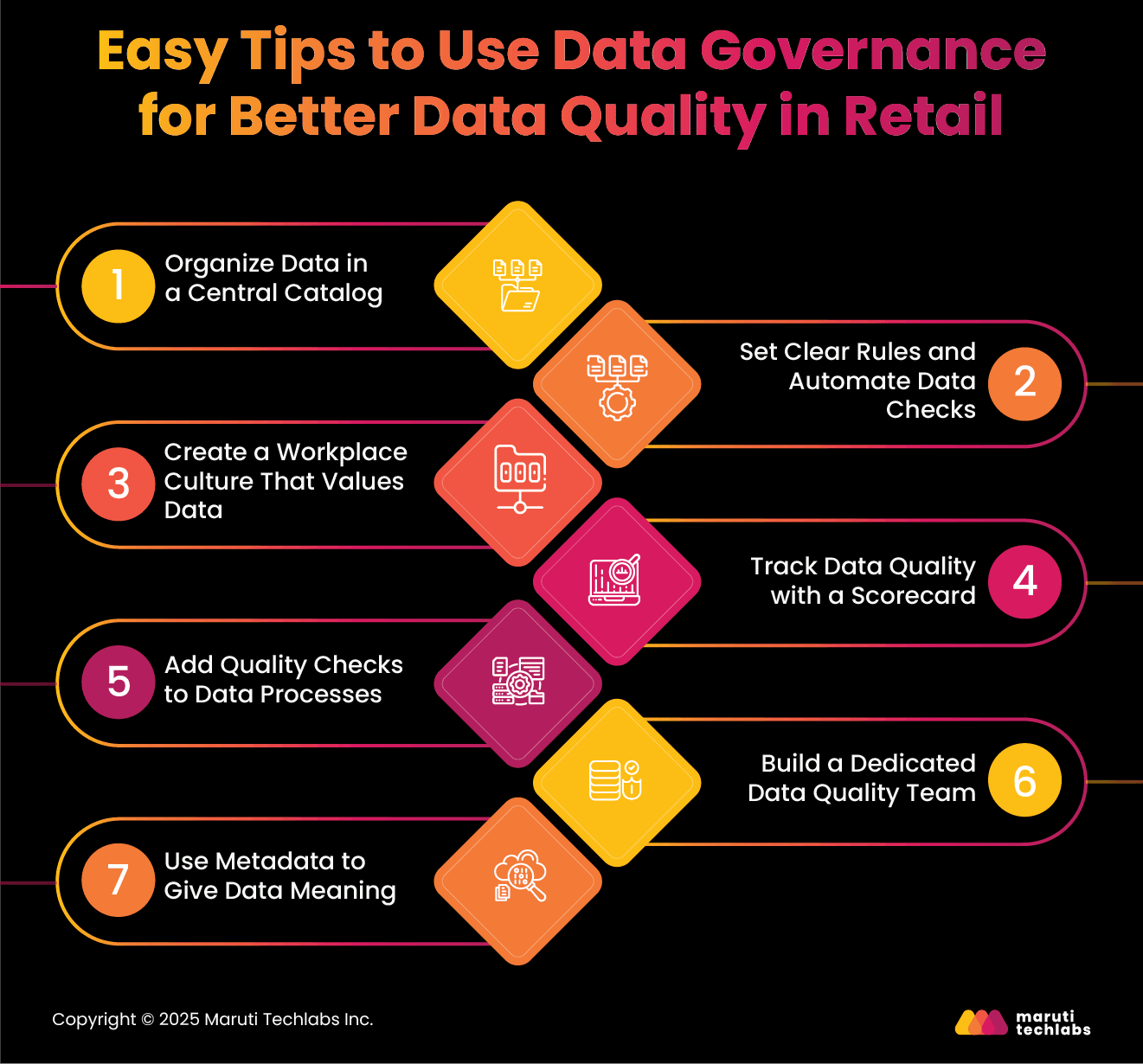

The Key to Smarter Retail Decisions: Strong Data Quality and Governance






Retailers rely on extensive customer data to manage their business. When managed effectively, this data reveals shopping patterns, improves marketing strategies, and enhances customer experience.
However, poor data quality can be costly. Inaccurate or outdated data leads to errors in decision-making, lost revenue, and poor customer experiences. A 2023 Gartner report found that businesses with strong data governance strategies reduce data errors by 20-40%. Banks using cloud-based data governance cut compliance-related IT costs by 30%. For retailers, better data management means improved inventory control, targeted promotions, and stronger customer trust.
This blog covers the key differences between data quality and data governance, why data quality is critical for retail success, how data governance supports data quality, and quick tips to improve data quality in retail.
Retail businesses use a lot of data to make decisions, connect with customers, and run their operations smoothly. Data quality ensures this information is correct, complete, and reliable so businesses can use it effectively. Data inaccurate or inconsistent can cause stock shortages, pricing mistakes, and revenue loss.
Data governance strategy is about keeping data organized and well-managed. It sets rules and assigns responsibilities to ensure data is safe, follows regulations, and is easy to access. While data quality ensures information is accurate and useful, data governance strategy provides the system to store, manage, and protect it effectively.
Understanding the differences between data quality and governance is key to managing data effectively. While both play essential roles, they serve different data handling and maintenance purposes. Here’s a breakdown of their key differences:
By integrating both data quality and governance tools, retailers can improve decision-making, enhance customer experiences, and maintain regulatory compliance.
Retailers rely on data to attract customers, improve sales, and stay ahead of competitors. But for data to be valuable, it must be accurate, complete, and reliable. Poor data quality can lead to incorrect product recommendations, delayed deliveries, and missed business opportunities. Here’s how clean, well-managed data helps retailers succeed:

Recommending relevant products is a great way to boost sales. Retailers suggest items based on past purchases, similar products, or what other customers with similar interests have bought. However, insufficient data can lead to mismatched or irrelevant recommendations. Even the best recommendation systems won’t work correctly without clean and accurate product and customer data.
Customers want their orders to arrive on time and at the right place. However, wrong or incomplete addresses can cause delays or failed deliveries. A survey found that 70% of customers had experienced shipping delays in six months. Retailers can prevent this by using accurate and verified address data, ensuring orders reach customers smoothly.
To stock the right products in the right places, retailers need to know what customers want and follow market trends. Clean data helps them study past shopping habits and predict demand. If the data is incorrect or messy, they might stock too many of the wrong items or run out of popular ones, causing lost sales and wasted money.
Customers now expect brands to understand their preferences and offer tailored experiences. However, retailers often struggle with duplicate or fragmented customer records. When retailers bring together data from different sources, they get a clear and accurate view of each customer. This helps them suggest the right products and create a smooth shopping experience across all channels.
Competitive pricing means tracking what other retailers are charging and adjusting prices accordingly. However, pricing data often comes from multiple sources and may be inconsistent. If retailers rely on incorrect or misrepresented data, they may set prices too high or too low, losing customers or profits.
Clean and standardized data helps retailers analyze competitor pricing accurately and make smarter pricing decisions.
Upselling means encouraging customers to buy a better version of a product, while cross-selling suggests related products that complement their purchase. Both techniques increase sales, but they require accurate customer and product data. If the data is incorrect, retailers might recommend irrelevant items and leads to missed opportunities and poor customer experiences.
By ensuring data is accurate and well-organized, retailers can offer better product recommendations, timely deliveries, competitive pricing, and personalized experiences that keep customers coming back.
Data governance in retail is a way to keep data organized and well-managed. It sets rules and processes to make sure data is accurate, safe, and easy to use.
Retailers collect data from multiple sources, including checkout systems, online stores, supply chains, and loyalty programs. Without proper management, this data can become messy and unreliable. Data governance tools help retailers organize and control their data, creating a clear and accurate view of customers and operations. This allows businesses to make better decisions and improve overall efficiency.
A strong data governance strategy directly improves data quality by ensuring consistency, accuracy, and proper management of information. Here’s how it helps:

Data governance sets clear rules on how data should be collected, stored, and used. These rules help businesses keep their data consistent, accurate, and reliable across all departments.
Putting specific people in charge of data quality helps keep it accurate. When someone is responsible, mistakes are found and fixed quickly which makes the data more reliable and consistent.
With strong data governance tools, retailers can see where their data comes from and how it changes over time. This makes it easier to spot mistakes early and stop incorrect data from spreading.
Good governance ensures that employees understand the importance of data quality. When teams know how poor data impacts decision-making, they are more careful in collecting and updating information.
Routine checks and audits help catch and fix errors before they become more significant. Ongoing monitoring ensures that data remains accurate, reduces risks, and improves decision-making.
A strong governance framework encourages businesses to invest in better data management tools, employee training, and expert oversight. This ensures long-term data quality and reliability.
By implementing strong data governance, retailers can improve data quality, reduce errors, and make smarter business decisions.
Strong data management helps retailers keep information accurate, organized, and easy to use. Businesses can avoid mistakes, work more efficiently, and make better decisions with a few simple steps. Here’s how:

A data catalog acts like a library, helping teams find and understand data easily. When all data is stored in one place with clear descriptions, employees can use it correctly, reducing mistakes and confusion.
Having clear guidelines on how data should be collected and used ensures consistency. Automated tools can check for errors in real time, saving time and preventing insufficient data from spreading.
Everyone in the company should understand why data quality matters. Training employees and encouraging them to follow good data practices helps maintain accuracy at every level.
Using a scorecard helps businesses measure how accurate and reliable their data is. It also highlights areas that need improvement and shows the impact of good data management.
Checking data for errors as collected and processed helps catch mistakes early. This prevents minor errors from becoming more significant problems later.
A team focused on data quality ensures that rules are followed, mistakes are fixed, and data stays accurate. They also help align data practices with business goals and compliance needs.
Metadata provides extra details about data, such as where it came from and how it should be used. This helps employees understand and apply the data correctly, making it more valuable for decision-making.
By following these steps, retailers can strengthen their data governance, improve data quality, and ensure they always have reliable information to guide their business decisions.
Strong data quality and governance are essential for making the right business decisions, staying compliant, and improving efficiency. Businesses risk inaccurate insights, operational issues, and lost opportunities without them.
Data governance provides the structure needed to keep data accurate, secure, and well-managed, while data quality ensures the information used is reliable and consistent. They help businesses build trust, streamline processes, and stay competitive.
At Maruti Techlabs, we specialize in data engineering services to help businesses clean, organize, and manage their data effectively. Whether you need better data governance or improved data quality, our team supports your data strategy.
Want to make the most of your data? Let’s connect and explore how we can help.
Data quality refers to the condition of your data, assessing its accuracy, completeness, relevance, and suitability for its purpose. Data governance focuses on maintaining data quality by managing its reliability, security, availability, and usability.
Data quality ensures data is accurate, complete, reliable, and fit for use, while data governance focuses on managing, controlling, and strategically using data within an organization.
Data governance pillars are key components of effective data management, including data quality, stewardship, protection and compliance, and management. Each ensures data integrity, security, and usability.
Retail governance is a structured approach to managing data assets through policies, processes, and standards to ensure data accuracy, security, accessibility, and usability.


